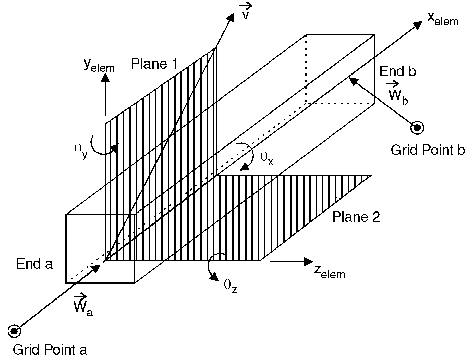PBAR |

|

|

|

|
|
PBAR |

|

|

|

|
Bulk Data Entry
PBAR – Simple Beam Property
Description
The PBAR bulk data entry defines the properties of a simple beam (bar), which is used to create bar elements via the CBAR entry.
Format
(1) |
(2) |
(3) |
(4) |
(5) |
(6) |
(7) |
(8) |
(9) |
(10) |
PBAR |
PID |
MID |
A |
I1 |
I2 |
J |
NSM |
|
|
|
C1 |
C2 |
D1 |
D2 |
E1 |
E2 |
F1 |
F2 |
|
|
K1 |
K2 |
I12 |
|
|
|
|
|
|
|
Field |
Contents |
PID |
Unique simple beam property identification number. No default (Integer > 0) |
MID |
Material identification number. See comment 1. No default (Integer > 0) |
A |
Area of bar cross-section. No default (Real > 0.0) |
I1 |
Area moment inertia in plane 1 about the neutral axis. No default (Real > 0.0) |
I2 |
Area moment inertia in plane 2 about the neutral axis. No default (Real > 0.0) |
I12 |
Area product of inertia. Default = 0.0 (Real) ( |
J |
Torsional constant. Default = 0.0 (Real > 0.0) |
NSM |
Nonstructural mass per unit length. Default = 0.0 (Real) |
K1, K2 |
Area factor for shear. Default = 0.0 (Real) |
Ci, Di, |
Stress recovery coefficients. Default = 0.0 (Real) |
| 1. | For structural problems, MID may reference only a MAT1 material entry. For heat transfer problems, MID may reference only a MAT4 material entry. |
| 2. | The transverse shear stiffness in planes 1 and 2 are (K1)AG and (K2)AG, respectively. The default values for K1 and K2 are infinite; in other words, the transverse shear flexibilities are set equal to zero. K1 and K2 are ignored if I12 ≠ 0. If a value of 0.0 is used for K1 and K2, the transverse shear flexibilities are set to 0.0 (K1 and K2 are interpreted as infinite). |
| 3. | The stress recovery coefficients C1 and C2, and so on, are the y and z coordinates in the BAR element coordinate system of a point at which stresses are computed. Stresses are computed at both ends of the BAR. |

Fig 1: Coordinate System for Bar Element (PBAR).
| 4. | The moments of inertia are defined as follows: |

| 5. | This card is represented as a property in HyperMesh. |
See Also: